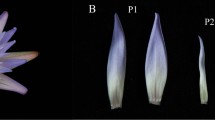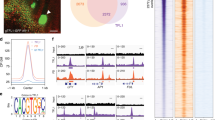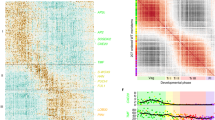Abstract
Although much progress has been made in understanding how floral organ identity is determined during the floral development, less is known about how floral organ is elaborated in the late floral developmental stages. Here we describe a novel floral mutant, w rinkled p etals and s tamens1 (wps1), which shows defects in the development of petals and stamens. Genetic analysis indicates that wps1 mutant is corresponding to a single recessive locus at the long arm of chromosome 3. The early development of floral organs in wps1 mutant is similar to that in wild type, and the malfunction of the mutant commences in late developmental stages, displaying a defect on the appearance of petals and stamens. In the mature flower, petals and stamen filaments in the mutant are wrinkled or folded, and the cellular morphology under L1 layer of petals and stamen filaments is abnormal. It is found that the expression patterns of floral organ identity genes are not affected in wps1 mutants compared with that of wild type, consistent with the unaltered development of all floral organs. Furthermore, the identities of epidermal cells in different type of petals are maintained. The histological analysis shows that in wps1 flowers all petals are irregularly folded, and there are knotted structures in the petals, while the shape and arrangement of inner cells are malformed and unorganized. Based on these results, we propose that Wps1 acts downstream to the class B floral organ identity genes, and functions to modulate the cellular differentiation during the late flower developmental stages.
Similar content being viewed by others
Log in or create a free account to read this content
Gain free access to this article, as well as selected content from this journal and more on nature.com
or
References
Coen ES, Meyerowitz EM . The war of the whorls: genetic interactions controlling flower development. Nature 1991; 353:31–37.
Ma H, dePamphilis C . The ABCs of floral evolution. Cell 2000; 101:5–8.
Colombo l, Franken J, Koetje E, et al. The petunia MADS box gene FBP11 determines ovule identity. Plant Cell 1995; 7:1859–1868.
Pelaz S, Ditta GS, Baumann E, Wisman E, Yanofsky M . B and C floral organ identity functions require SEPALLATA MADS-box genes. Nature 2000; 405: 200–203.
Sablowski RW, Meyerowitz EM . A homolog of NO APICAL MERISTEM is an immediate target of the floral homeotic genes APETALA3/PISTILLATA. Cell 1998; 92:93–103.
Zik M, Irish VF . Global identification of target genes regulated by APETALA3 and PISTILLATA floral homeotic gene action. Plant Cell 2003; 15:207–222.
Wellmer F, Riechmann JL, Alves-Ferreira M, Meyerowitz EM . Genome-wide analysis of spatial gene expression in Arabidopsis flowers. Plant Cell 2004; 16:1314–1326.
Handberg K, Stougaard J . Lotus japonicus, an autogamous diploid legume species for classical and molecular genetics. Plant J 1992; 2:487–496.
Perry JA, Wang TL, Welham TJ, et al. A TILLING reverse genetics tool and a web-accessible collection of mutants of the legume Lotus japonicus. Plant Physiol 2003; 131:866–871.
Somers DA, Samac DA, Olhoft PM . Recent advances in legume transformation. Plant Physiol 2003; 131:892–899.
VandenBosch KA, Stacey G . Summaries of legume genomics projects from around the globe: community resources for crops and models. Plant Physiol 2003; 131: 840–865.
Sato S, Kaneko T, Nakamura Y, et al. Structural analysis of the Lotus japonicus genome. I. Sequence features and mapping of fifty-six TAC clones which cover the 5.4Mb regions of the genome. DNA Res 2001; 8:311–318.
Imaizumi-Anraku H, Kawaguchi M, Koiwa H, Akao S, Syono K . Two ineffective nodulating mutants of Lotus japonicus: different phenotypes caused by the blockage of endocytotic bacterial release and nodule maturation. Plant Cell Physiol 1997; 38:871–881.
Schauser L, Handberg K, Sandal N, et al. Symbiotic plant mutants deficient in nodule establishment identified after T-DNA transformation of Lotus japonicus. Mol Gen Genet 1998; 259:414–423.
Hayashi M, Miyahara A, Sato S, et al. Construction of a genetic linkage map of the model legume Lotus japonicus using an intraspecific F2 population. DNA Res 2001; 8:301–310.
Sandal N, Krusell L, Radutoiu S, et al. A genetic linkage map of the model legume Lotus japonicus and strategies for fast mapping of new loci. Genetics 2002; 161: 1673–1683.
Ferrandiz C, Navarro C, Gomez MD, Canas LA, Beltran JP . Flower development in Pisum sativum: from the war of the whorls to the battle of the common primordium. Dev Genet 1999; 25:280–290.
Benlloch R, Navarro C, Beltran JP, Canas LA . Floral development of the model legume Medicago truncatula: ontogeny studies as a tool to better characterize homeotic mutations. Sex Plant Reprod 2003; 15:231–241.
Tucker SC . Overlapping organ initiation and common primordia in flowers of Pisum sativum (Leguminosae: Papilionoideae). Am J Bot 1989; 74:714–729.
Dong ZC, Zhao Z, Liu CW, et al. Floral patterning in Lotus japonicus. Plant Physiol 2005; 137:1271–1282.
Feng XZ, Zhao Z, Tian ZX, et al. Control of petal shape and floral zygomorphy in Lotus japonicus. Proc Natl Acad Sci U S A 2006 Mar; in press (online: www.pnas.org/cgi/doi/10.1073/pnas.0600681103)
Jackson D, Veit B, Hake S . Expression of maize KNOTTED1 related homeobox genes in the shoot apical meristem predicts patterns of morphogenesis in the vegetative shoot. Development 1994; 120:405–413.
Kawaguchi M, Motomura T, Imaizumi-Anraku H, Akao S, Kawasaki S . Providing the basis for genomics in Lotus japonicus: the accession Miyakojima and Gifu are appropriate crossing partners for genetic analyses. Mol Genet Genomics 2001; 266:157–166.
Coen ES, Romero JM, Doyle S, et al. floricaula: a homeotic gene required for flower development in Antirrhinum majus. Cell 1990; 63:1311–1322.
Choi HK, Mun JH, Kim DJ, et al. Estimating genome conservation between crop and model legume species. Proc Natl Acad Sci USA 2004; 101:15289–15294.
Ng M, Yanofsky MF . Function and evolution of the plant MADS-box gene family. Nat Rev Genet 2001; 2:186–195.
Bey M, Stuber K, Fellenberg K, et al. Characterization of Antirrhinum petal development and identification of target genes of class B MADS box gene DEFICIENS. Plant Cell 2004; 16:3197–3215.
Donnelly PM, Bonetta D, Tsukaya H, et al. Cell cycling and cell enlargement in developing leaves of Arabidopsis. Dev Biol 1999; 215:407–419.
Nath U, Crawford BC, Carpenter R, Coen E . Genetic control of surface curvature. Science 2003; 299:1404–1407.
Palatnik JF, Allen E, Wu X, et al. Control of leaf morphogenesis by microRNAs. Nature 2003; 425:257–263.
Cubas P, Lauter N, Doebley J, Coen E . The TCP domain: a motif found in proteins regulating plant growth and development. Plant J. 1999; 18:215–222.
Acknowledgements
The authors thank Mr Qin Peng Mong, Xiao Feng Li, Satoshi Tabata, Shusei Sato and Jun Yang for their help to conduct the experiment, and Dr Liang Huang for helpful revision of the manuscript. This research was financially supported by the National Natural Science Foundation of China (Grant No. 30430330).
Author information
Authors and Affiliations
Corresponding author
Rights and permissions
About this article
Cite this article
Chen, J., Pang, J., Wang, L. et al. Wrinkled petals and stamens 1, is required for the morphogenesis of petals and stamens in Lotus japonicus. Cell Res 16, 499–506 (2006). https://doi.org/10.1038/sj.cr.7310061
Received:
Revised:
Accepted:
Published:
Issue date:
DOI: https://doi.org/10.1038/sj.cr.7310061



